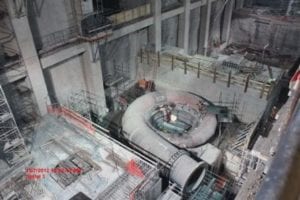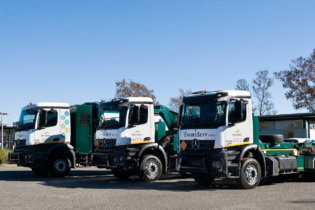The multi-billion Rand Ingula Pumped Storage Scheme, like many around the world of this magnitude and complexity has suffered delays not least the site closure ordered by the Department of Labour after last year’s tragic accident that claimed the lives of six construction workers. However progress has been made since the incident in October last year on both underground and on above ground facilities.
The Ingula Pumped Storage Scheme is now in its seventh year of construction and had it not been for the tragic accident one of the four 333MW reversible pump turbines would be undergoing commissioning at this time. The Eskom project is located between Ladysmith and Harrismith in the Little Drakensberg, and will have a generating capacity of 1332MW available during periods of peak demand and to supplement base load when necessary – for example during outages or essential maintenance of other generating plant. Ingula is a peaking hydro power station comprising an upper and a lower dam or reservoir separated in elevation by 480m, an underground powerhouse located 116 storeys underground in two excavated underground caverns and housing 4 x 333MW Francis type pumps/turbines. An underground labyrinth of interconnecting tunnels/waterways extends 6.5kmand 3km of access tunnels and a number of shafts allow water to be released from the upper Bedford Dam and delivered to the turbines producing power, before being captured in the lower Bramhoek Dam. During off-peak times – at night for example – the turbines are reversed pumping water back from Bramhoek Dam to Bedford, in readiness for the next peak event. Construction Senior Supervisor Jacques du Plessis from consultants Royal HaskoningDHV, one of the three firms of consultants that make up the design and construction supervision team, Braamhoek Consultants Joint Venture, explains recent progress milestones.“Underground work is proceeding apace with the concrete lining in the tailrace and headrace tunnels completed, cavity and consolidation tunnel grouting are about 75% complete and concrete slip forming at one of two 91m high Surge Chambers recently commenced. All civil works in the transformer hall have been completed and the machine hall and underground control room are nearing completion” he explained.
“The first turbine shaft and runner were taken underground recently, two generator transformers have been installed and mechanical and electrical fit-out work is underway. Above ground the operations and maintenance building on the intake structure is nearing completion as is the stop log storage facility at the outlet” said du Plessis.
The double-storey Administration Building, whose basement has direct access to the main tunnel leading to the underground power station, has also recently been completed. In addition to office space, the building accommodates the external control centre for the power station. Also recently completed is the Visitors Centre, which comprises a small office wing, a cinema, various display halls, an auditorium and facilities wings. The surrounding area will be landscaped with indigenous plants to minimize the visual impact of the surface buildings.








